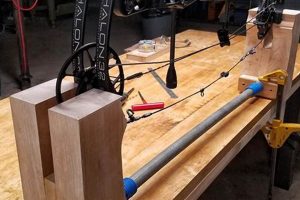Creating a bean bag toss game from scratch involves the self-directed construction of a recreational activity, typically employing wood, fabric, and. This process allows individuals to customize the size, design, and materials used in the game. For example, one might choose to use reclaimed wood for the platform and durable duck cloth for the bean bags.
Engaging in the construction of such a game offers numerous advantages, including cost savings compared to purchasing a pre-made version and the satisfaction of creating a personalized item. Historically, homemade games have provided accessible entertainment, fostering social interaction and friendly competition. The ability to tailor the game to specific preferences, such as incorporating unique artwork or adapting the size for space constraints, enhances its value.
The subsequent sections will detail specific construction methods, material selection criteria, and design considerations for individuals interested in undertaking this project. Emphasis will be placed on achieving both structural integrity and aesthetic appeal in the finished product.
Essential Guidance for Homemade Bean Bag Toss Game Construction
The following recommendations are designed to optimize the outcome of a self-directed bean bag toss game project, focusing on aspects of durability, precision, and safety.
Tip 1: Prioritize wood selection. Opt for cabinet-grade plywood with a thickness of at least 1/2 inch to ensure a stable and warp-resistant playing surface. Avoid using lower-grade materials that may compromise the structural integrity of the platform.
Tip 2: Implement precise measurements. Adherence to official regulation sizes24 inches by 48 inches for the board and a 6-inch diameter hole centered 9 inches from the topis crucial for standardized gameplay. Inaccurate dimensions can negatively impact the game’s fairness and playability.
Tip 3: Reinforce structural joints. Use wood glue in conjunction with screws or nails to create robust connections between the frame and the playing surface. This will minimize the risk of separation or loosening over time, especially with frequent use.
Tip 4: Ensure a smooth playing surface. Thoroughly sand the wood surface to eliminate any splinters or imperfections. Apply multiple coats of sealant or varnish to create a slick, consistent playing field that allows the bean bags to slide appropriately.
Tip 5: Use durable fabric for bean bags. Duck cloth or canvas are recommended for their resistance to tearing and wear. Fill the bags with approximately 16 ounces of dried corn or plastic pellets, ensuring consistent weight and distribution.
Tip 6: Employ secure stitching techniques. Double-stitch or serge the bean bag seams to prevent leakage of the fill material. Reinforce the corners with additional stitching for enhanced durability.
Tip 7: Integrate leg supports for stability. Foldable or fixed legs should be attached securely to the frame, providing a stable base during gameplay. Ensure that the legs are angled appropriately to achieve the regulation board height of 12 inches at the front and 4 inches at the back.
Adhering to these guidelines will contribute to the creation of a durable, regulation-compliant, and enjoyable bean bag toss game. The investment in quality materials and careful construction techniques will yield a product that offers lasting entertainment.
The subsequent section will address customization options and aesthetic enhancements for the finished game.
1. Material Selection
Material selection is a critical determinant in the quality, durability, and playability of a self-constructed bean bag toss game. The choice of materials directly impacts the game’s structural integrity, resistance to environmental factors, and overall aesthetic appeal. Careful consideration should be given to each component, ensuring its suitability for both intended use and long-term performance.
- Plywood Grade and Thickness
The grade and thickness of the plywood used for the playing surface profoundly influence its resistance to warping, sagging, and general wear. Cabinet-grade plywood, typically with a thickness of at least 1/2 inch, provides a stable and consistent playing surface. Lower-grade plywoods may exhibit imperfections or inconsistencies that can negatively impact gameplay and longevity.
- Wood for Framing and Legs
The lumber used for the frame and legs determines the structural stability of the entire game. Hardwoods, such as oak or maple, offer superior strength and resistance to impact compared to softwoods like pine. The selection of appropriately sized and treated lumber is essential for preventing structural failure during gameplay. Further treatment with preservatives is needed if the set will be outside in the weather.
- Fabric for Bean Bags
The fabric used for the bean bags must withstand repeated throwing and impact without tearing or degrading. Durable materials like duck cloth or canvas are commonly used due to their tight weave and resistance to abrasion. Lighter fabrics may quickly develop holes or tears, leading to the loss of filling and compromising gameplay.
- Filling Material for Bean Bags
The choice of filling material affects the weight, feel, and performance of the bean bags. Dried corn is a traditional filling material, providing a natural feel and consistent weight. Plastic pellets offer a more weather-resistant alternative, preventing mold or decay. The selection of the proper filling material influences the bag’s ability to land and stay on the board, thus impacting gameplay.
These material choices ultimately determine the success of a self-directed bean bag toss game project. Opting for high-quality, durable materials will ensure a playing experience that is both enjoyable and long-lasting. Conversely, skimping on material quality may lead to premature wear, structural failures, and a compromised gaming experience.
2. Precise Dimensions
The construction of a bean bag toss game necessitates strict adherence to specified measurements. Deviation from these standardized dimensions directly impacts gameplay dynamics. The regulation size of the playing surface (24 inches by 48 inches) and the hole’s diameter (6 inches) were established to provide a consistent level of challenge. For instance, a smaller target area would artificially increase difficulty, while a larger one would diminish the skill element. The hole’s placement (9 inches from the top, centered horizontally) is similarly critical; incorrect positioning could cause unpredictable bag trajectories and unfair advantages.
The practical significance of precise dimensions extends beyond fair play. Non-compliant boards might be excluded from organized tournaments or casual games
where adherence to regulations is expected. Furthermore, accurate measurements contribute to the game’s structural integrity. Incorrectly sized components can lead to instability or premature wear. For example, if the frame is not perfectly square, the playing surface might not sit flush, creating uneven ballistics. Precise dimensions also inform the spacing and angle of the legs, ensuring that the board maintains the correct inclination for proper gameplay, adhering to the standards established by governing bodies.
In summary, meticulous attention to dimensions is paramount when undertaking such a project. It ensures fair and consistent gameplay, enhances the board’s structural integrity, and allows participation in standardized events. Disregarding these specifications undermines the game’s intended design and ultimately diminishes the user experience. Thus, prior to commencing construction, one must secure and meticulously follow precise dimension guidelines to optimize the final product.
3. Joint Reinforcement
Within the context of bean bag toss game construction, joint reinforcement constitutes a critical factor influencing the structural integrity and longevity of the finished product. The game, by its nature, is subjected to repetitive impact and stress, particularly at the junctures where different components are joined. Insufficient reinforcement at these points can result in structural failure, rendering the game unusable or, at the very least, diminishing its performance and lifespan. For example, a frame constructed with only nails and without adequate wood glue at the joints may separate over time due to the constant force of the bean bags impacting the playing surface.
Effective joint reinforcement strategies within bean bag toss game assembly often involve the combined use of mechanical fasteners and adhesives. Wood screws, as opposed to nails, provide a stronger and more durable connection, resisting pull-out forces generated during use. Wood glue, specifically formulated for bonding wood, further strengthens the joints by creating a continuous bond between the surfaces. Bracing the corners of the frame with additional pieces of wood or metal brackets is another common technique for distributing stress and preventing joint failure. Consider a scenario where a game is used frequently at outdoor events; without proper joint reinforcement, the constant handling and exposure to varying weather conditions will accelerate the degradation of weak joints.
In summation, the implementation of robust joint reinforcement techniques is not merely a desirable feature but a fundamental requirement for a durable and high-performing bean bag toss game. Failure to adequately reinforce the joints will inevitably lead to structural problems and a reduced lifespan. Therefore, careful planning and execution of joint reinforcement strategies are crucial to maximize the value and enjoyment derived from such a project.
4. Surface Finish
The surface finish applied during bean bag toss game construction, or when engaging in a bean bag toss game do it yourself project, transcends mere aesthetic considerations; it is a critical functional element that directly influences gameplay and board longevity. The application of appropriate coatings, textures, and treatments to the playing surface impacts the slide of the bean bags, protects the underlying wood from environmental damage, and contributes to the overall durability of the game.
- Slide Consistency and Control
A well-executed surface finish promotes a consistent and predictable slide for the bean bags. Variations in texture or uneven application of the finish can result in unpredictable bag behavior, diminishing the skill element of the game. For instance, a high-gloss polyurethane coating, when properly applied, creates a slick surface that allows for controlled slides, whereas a rough or uneven surface may cause the bags to snag or bounce erratically.
- Protection Against Environmental Damage
Exterior-grade sealants and varnishes safeguard the underlying wood from moisture, UV radiation, and physical abrasion. Exposure to these elements can lead to warping, cracking, and fading, ultimately compromising the structural integrity of the game. A properly applied finish acts as a barrier, extending the lifespan of the board and maintaining its aesthetic appeal. Consider a game left outdoors; a protective finish prevents water damage and UV-induced discoloration.
- Durability and Resistance to Wear
The surface finish provides a layer of protection against the constant impact of bean bags. A durable finish resists chipping, scratching, and other forms of wear, ensuring that the playing surface remains smooth and consistent over time. A multi-layer epoxy finish, for example, offers superior impact resistance compared to a single coat of varnish, preserving the playing surface even with frequent use.
- Aesthetic Enhancement and Customization
While functional benefits are paramount, the surface finish also offers opportunities for aesthetic customization. Various finishes, such as stains, paints, and decorative coatings, can be used to create a visually appealing game that reflects personal preferences or matches a specific theme. A carefully chosen stain can enhance the natural wood grain, while a vibrant paint job can add a touch of personality to the game.
In conclusion, selecting and applying an appropriate surface finish is an integral part of bean bag toss game DIY construction. It not only elevates the aesthetic appeal of the game but also contributes significantly to its functionality, durability, and overall playing experience. The investment in a quality surface finish is an investment in the long-term enjoyment and performance of the game.
5. Bag Durability
Bag durability represents a crucial consideration within the context of bean bag toss game do it yourself projects. The longevity and consistent performance of the bean bags directly influence the overall enjoyment and usability of the homemade game. Therefore, material selection, construction techniques, and maintenance practices must prioritize robustness to withstand repeated use and environmental factors.
- Fabric Selection and Tensile Strength
The choice of fabric dictates the bag’s resistance to tearing and abrasion. Durable materials such as duck cloth or heavy canvas, characterized by high tensile strength, are recommended. Thinner, less resilient fabrics are prone to premature failure, compromising the bag’s integrity and necessitating frequent repairs or replacements. An example is the use of 10-ounce duck cloth over a standard cotton fabric, which significantly extends the lifespan of the bag under heavy usage.
- Seam Construction and Stitching Techniques
The method of seam construction directly affects the bag’s ability to contain the filling material under stress. Double-stitched or serged seams offer superior strength compared to single-stitched seams, minimizing the risk of splitting or unraveling. Reinforcing corners with additional stitching further mitigates stress concentration in these vulne
rable areas. A practical example is using a zigzag stitch along the seam to provide greater flexibility and prevent tearing when the bag impacts the board. - Fill Material and Resistance to Degradation
The filling material must be resistant to moisture, mold, and compression. Traditional dried corn, while cost-effective, is susceptible to degradation if exposed to moisture. Plastic pellets or treated corn offer increased resistance to environmental factors, prolonging the bag’s usable life. For instance, using polypropylene pellets ensures that the bags retain their shape and weight distribution even after prolonged exposure to humid conditions.
- UV Resistance and Colorfastness
For bean bag toss games intended for outdoor use, the fabric’s resistance to ultraviolet (UV) radiation is a significant factor. Prolonged exposure to sunlight can cause fading and weakening of the fabric, reducing its durability and aesthetic appeal. Selecting fabrics with UV-resistant dyes and coatings helps maintain the bag’s color and structural integrity over time. An example is the use of solution-dyed acrylic fabrics, which exhibit superior colorfastness compared to conventionally dyed materials.
The interconnectedness of these facets underscores the importance of a holistic approach to bag durability in bean bag toss game do it yourself projects. By carefully considering material properties, construction methods, and environmental factors, constructors can create bean bags that withstand the rigors of regular use, ensuring a long-lasting and enjoyable gaming experience. The investment in durable materials and sound construction techniques directly translates to a more robust and reliable game set.
Frequently Asked Questions
This section addresses common inquiries regarding the self-directed creation of a bean bag toss game, providing detailed explanations to aid in the construction process.
Question 1: What is the minimum recommended thickness for plywood used in the construction of a bean bag toss game playing surface?
A plywood thickness of at least 1/2 inch is advised to mitigate warping and ensure a stable playing field. Thicker plywood may provide increased durability, particularly under heavy use, but adds to the overall weight of the structure.
Question 2: Are there specific regulations governing the dimensions of a bean bag toss game and its components?
Yes. Official regulations stipulate that the playing surface should measure 24 inches by 48 inches, with a 6-inch diameter hole centered 9 inches from the top edge. Bean bags should measure approximately 6 inches square and weigh between 15 and 16 ounces.
Question 3: What type of fastener is most suitable for securing the frame components of a bean bag toss game?
Wood screws are preferable to nails for securing frame components due to their superior holding power. Pre-drilling pilot holes before inserting screws minimizes the risk of wood splitting. Adhesive wood glue, applied in conjunction with screws, further strengthens the joints.
Question 4: What are the recommended materials for filling bean bags, and what are their relative advantages?
Dried corn and plastic pellets are common filling materials. Dried corn offers a traditional feel but is susceptible to moisture damage. Plastic pellets provide better resistance to moisture and decay, extending the lifespan of the bags, particularly in humid environments.
Question 5: Is it necessary to apply a sealant or finish to the playing surface of a self-constructed bean bag toss game?
Yes, applying a sealant or finish is crucial for protecting the wood from moisture, UV radiation, and abrasion. A smooth, even finish also facilitates consistent bag slide. Multiple coats of polyurethane or a similar sealant are recommended for optimal protection and performance.
Question 6: What considerations should be taken into account when designing the legs for a bean bag toss game?
Legs should be constructed from durable lumber and attached securely to the frame. The front legs should elevate the playing surface to a height of 12 inches, while the rear legs should elevate it to 4 inches, creating the proper angle for gameplay. Folding leg mechanisms can facilitate storage and transport.
Adherence to these guidelines promotes the creation of a durable, regulation-compliant, and enjoyable bean bag toss game. Careful planning and attention to detail are paramount to achieving a successful outcome.
The subsequent section will explore advanced design considerations and customization options for homemade bean bag toss games.
Concluding Remarks on Bean Bag Toss Game Construction
This exposition has detailed the essential aspects of bean bag toss game DIY projects, covering material selection, dimensional accuracy, joint reinforcement, surface finishing, and bag durability. Understanding these elements is paramount for constructing a game that meets both functional and aesthetic requirements, ensuring a product that withstands regular use and delivers an engaging experience.
The decision to undertake the construction of a bean bag toss game represents an investment in craftsmanship and personalized recreation. With diligent application of the principles outlined herein, individuals can create a durable and enjoyable game that enhances social gatherings and offers lasting entertainment. Continued exploration of advanced techniques and innovative design modifications will undoubtedly further elevate the art of DIY game construction.







